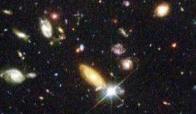





Scientific RationaleThis last decade has witnessed a revolution in our way to see galaxies; in particular deep imaging with the Hubble Space Telescope and the VLT have uncovered a large number of objects that are difficult to place along the Hubble sequence. HST has allowed to see galaxy morphologies much farther back in time than any telescope before; since looking farther means looking back in time in astronomy, this has uncovered directly the morphological aspects of galaxy evolution. High resolution spectroscopy of extremely faint objects allows to study the kinematic evolution and, hence, mass assembly of galaxies to unprecedented look-back times for direct comparison with predictions of cosmological structure formation scenarios. With HST, ISO, Spitzer, GALEX, Chandra, XMM and large ground base telescopes covering the wavelength basis from X-rays through radio wavelengths, it is now possible to study all 3 aspects of galaxy evolution -- their morphological-dynamical, chemical and spectral evolution out to red-shift larger than 6, hence, explore more than 95% of the age of the universe. This will be possible at the time of the conference, especially as it coincides with the release of large surveys with GALEX and Spitzer. It is now possible to bring together observers, people performing numerical simulations, and theoreticians, those working on the local and distant universe to confront ideas on galaxy evolution with direct observations. It is therefore timely to hold a Symposium during the General Assembly in Prague in 2006 to discuss the key problems arising in the domain of galaxy evolution: -- How and when was the present Hubble sequence of galaxies established? What determines galaxy morphologies in cosmological structure formation scenarios? The main physical processes transforming galaxies are the galaxy interactions and mergers, and external accretion and outflows, combined with secular evolution. Their respective roles in shaping disks, bulges or spheroids have to be better defined. -- What is the efficiency of star formation through the Hubble time? How star formation is linked and affects galaxy morphology? -- How can the study of stellar populations and chemical abundances diagnose the history of the mass assembly and star formation in galaxies? and how does it compare to the direct observation of evolution? -- What's the role of environmental effects in galaxy groups and clusters, such as ram pressure and tidal stripping, galaxy -- galaxy interactions, merging and starbursts, mutual relations between galaxy evolution/transformation and formation/evolution of clusters? -- Can we identify the contribution of galaxies along the Hubble time to the present cosmic background radiation at any wavelength? An international meeting focused on similar issues was the Tenerife Conference, in December 1998, on "Evolution of Galaxies on Cosmological Timescales", and we can already quantify the considerable progress made since seven years. We stress that our epoch is a privileged time for the study of galaxy evolution, with huge surveys, for instance the Sloan Survey and the various Deep Fields, yielding the best constraints on galaxy evolution ever obtained, and the promise of multi-wavelength instruments with expected breakthroughs in the domain of remote galaxies (ALMA, Herschel), or the next generation space telescope JWST. |